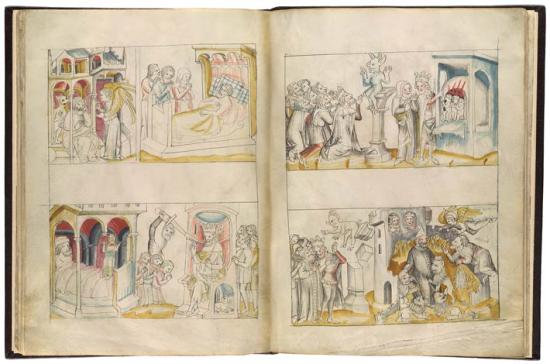
History Bible, in Latin and German
Purchased by Pierpont Morgan, 1907
Alexander the Great Fashionista
Alexander the Great, especially in the scenes at the lower right, exhibits the wasp waist and bulbous torso that characterize the fashionable look for men during the second half of the fourteenth century. Buttons and padding in the doublet's chest and shoulders helped achieve this hourglass silhouette. A low-slung "Bohemian" girdle and pouleines (pointed shoes) complete the look. The women in these vignettes, including Candace (to whom the king makes love), are depicted with similar silhouettes. The woman's distinctively frilly ruffled hood is particular to Germany and parts of the Netherlands but not France.
Wasp Waists and Stuffed Shirts
The second half of the fourteenth century was a bleak period in French history. The Black Plague, which first struck in 1348, was a recurring horror. As the Hundred Years' War dragged on, France suffered devastating defeats by the English. Following the Battle of Poitiers in 1356, King John II was captured and taken to London as a prisoner. Fashions changed little during this period.
Men's fashion was dominated by the pourpoint: a close-fitting doublet influenced by the military. With a short flaring skirt and a cinched waist, the pourpoint was padded at the chest and shoulders, giving its wearer a distinctive hourglass silhouette. Pouleines, long pointed shoes, and belts—slender, or the thick "Bohemian" girdle—worn low on the hips complimented the look.
The cote hardy—an outer garment for women—while retaining its voluminous skirt, got even tighter at the bodice, bosom, and sleeves. The resulting look paralleled that of men's fashion. Tippets, decorative strips of cloth hanging from the arms, remained popular. Both men and women continued to wear the chaperon (the hood with attached cape and tail).
